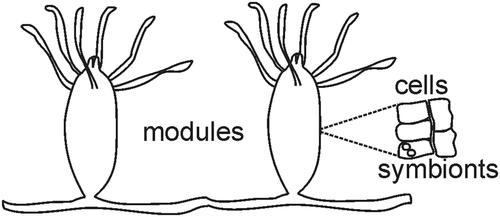当前位置:
X-MOL 学术
›
J. Exp. Zool. B Mol. Dev. Evol.
›
论文详情
Our official English website, www.x-mol.net, welcomes your
feedback! (Note: you will need to create a separate account there.)
Evolutionary conflict and coloniality in animals
Journal of Experimental Zoology-B: Molecular and Developmental Evolution ( IF 1.8 ) Pub Date : 2020-01-10 , DOI: 10.1002/jez.b.22924 Neil W Blackstone 1
Journal of Experimental Zoology-B: Molecular and Developmental Evolution ( IF 1.8 ) Pub Date : 2020-01-10 , DOI: 10.1002/jez.b.22924 Neil W Blackstone 1
Affiliation

|
Despite considerable interest in the effects of evolutionary conflict in colonies of social insects, relatively little attention has been paid to this issue in clonal animals with modular construction, such as colonial ascidians, bryozoans, and cnidarians. These colonial animals are structural individuals, subdivided into repeated morphological modules, which can individually acquire, process, and share resources. While size‐related selection favors colony formation, evolutionary conflicts remain a potent obstacle to such cooperation. These conflicts can occur at several levels and must be mediated for cooperation to emerge. Module‐level conflicts potentially result in coalitions of genetically similar modules failing to share resources or monopolizing reproduction. Mediation occurs by a number of mechanisms including: (a) a single‐module bottleneck at the initiation of colony formation, (b) allorecognition that limits colony fusion to close kin, (c) development of new modules from connective tissue, (d) synchronization of module budding, (e) programmed module death, (f) terminal differentiation of reproductive modules, and (g) architectural constraints. Effective mediation of module‐level conflicts, however, may in some cases contribute to cell‐level conflicts. Animal colonies typically have multipotent stem cells, and genetically variant stem cells can potentially monopolize gamete formation. Limiting colony fusion to close kin may not eliminate such conflict. Finally, in at least some taxa an association between photosymbiosis and coloniality is found. Allocation of photosynthate can lead to host‐symbiont conflicts that can be mediated by housing symbionts intracellularly and using chemiosmotic mechanisms to detect defectors. Colonial animals thus serve as a living laboratory of evolutionary conflict and its mediation.
中文翻译:

动物的进化冲突和殖民性
尽管人们对群居昆虫群落中进化冲突的影响相当感兴趣,但在具有模块化结构的克隆动物(例如群居海鞘、苔藓动物和刺胞动物)中,对这个问题的关注相对较少。这些殖民地动物是结构个体,细分为重复的形态模块,可以单独获取、处理和共享资源。虽然与大小相关的选择有利于群体的形成,但进化冲突仍然是这种合作的潜在障碍。这些冲突可能发生在多个层面,必须进行调解才能出现合作。模块级冲突可能导致基因相似模块的联盟无法共享资源或垄断繁殖。调解通过多种机制进行,包括:(a) 集落形成初期的单模块瓶颈,(b) 限制集落融合到近亲的同种异体识别,(c) 从结缔组织开发新模块,(d) 模块出芽的同步,(e) 程序化模块死亡,(f)生殖模块的终末分化,以及(g)架构限制。然而,模块级冲突的有效调解在某些情况下可能会导致单元级冲突。动物群体通常具有多能干细胞,而基因变异的干细胞可能会垄断配子的形成。将殖民地融合限制为近亲可能无法消除这种冲突。最后,至少在某些分类群中发现了光共生和殖民性之间的关联。光合产物的分配会导致宿主-共生体冲突,这可以通过在细胞内容纳共生体和使用化学渗透机制来检测缺陷者来介导。因此,殖民地动物充当了进化冲突及其调解的活实验室。
更新日期:2020-01-10
中文翻译:

动物的进化冲突和殖民性
尽管人们对群居昆虫群落中进化冲突的影响相当感兴趣,但在具有模块化结构的克隆动物(例如群居海鞘、苔藓动物和刺胞动物)中,对这个问题的关注相对较少。这些殖民地动物是结构个体,细分为重复的形态模块,可以单独获取、处理和共享资源。虽然与大小相关的选择有利于群体的形成,但进化冲突仍然是这种合作的潜在障碍。这些冲突可能发生在多个层面,必须进行调解才能出现合作。模块级冲突可能导致基因相似模块的联盟无法共享资源或垄断繁殖。调解通过多种机制进行,包括:(a) 集落形成初期的单模块瓶颈,(b) 限制集落融合到近亲的同种异体识别,(c) 从结缔组织开发新模块,(d) 模块出芽的同步,(e) 程序化模块死亡,(f)生殖模块的终末分化,以及(g)架构限制。然而,模块级冲突的有效调解在某些情况下可能会导致单元级冲突。动物群体通常具有多能干细胞,而基因变异的干细胞可能会垄断配子的形成。将殖民地融合限制为近亲可能无法消除这种冲突。最后,至少在某些分类群中发现了光共生和殖民性之间的关联。光合产物的分配会导致宿主-共生体冲突,这可以通过在细胞内容纳共生体和使用化学渗透机制来检测缺陷者来介导。因此,殖民地动物充当了进化冲突及其调解的活实验室。











































 京公网安备 11010802027423号
京公网安备 11010802027423号